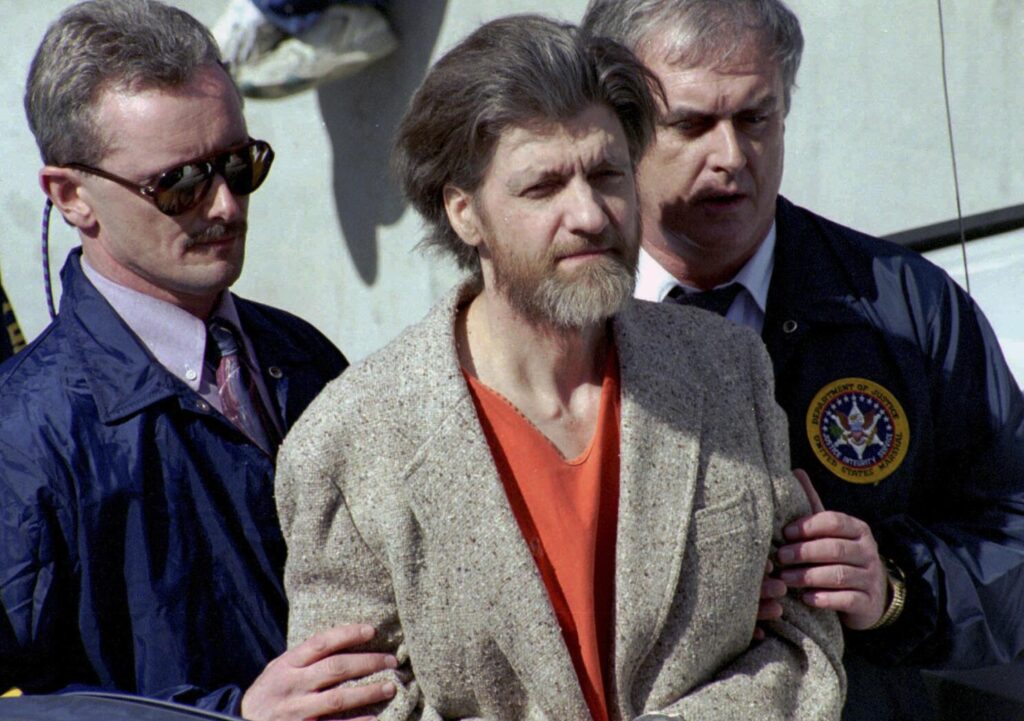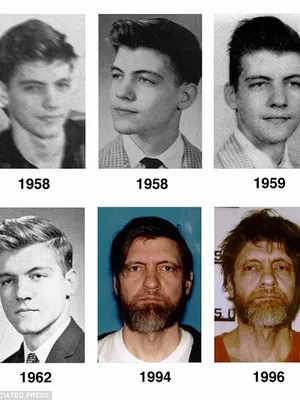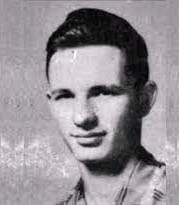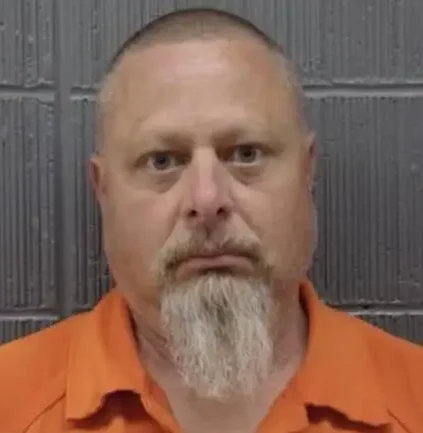
For nearly two decades a mathematical genius with delusions of single-handedly destroying industrial society, planted or mail powerful bombs to unsuspecting innocent victims. It was a spree of mayhem that killed three and wounded over two dozen. In the largest and most expensive investigation in FBI history, agents spent 17 years hunting for the elusive terrorists known as the Unabomber.
The first bomb came in the spring of 1978. The damage it caused was minimal, but its impact would be enormous. With each new detonation the bomber learned a little more about bombs and law enforcement learned a little more about the man who sent them. Because its targets were universities and Airlines the FBI called him the Unabomber. Before they ever knew the name Ted Kaczynski, they knew they were dealing with a disgruntled genius. Between 1978 and 1995, Kaczynski mailed or hand-delivered a series of increasingly sophisticated bombs that cumulatively killed three people and injured 23 others. Sixteen bombs were attributed to Kaczynski. While the bombing devices varied widely through the years, many contained the initials “FC”, which Kaczynski later said stood for “Freedom Club”.
On May 25th 1978, an engineering professor named Buckley Crist at Northwestern University in Evanston Illinois appeared in the mail room with a shoebox sized parsley. Professor Chris was listed as the return addressee and he didn’t know the man it was addressed to. Campus security guard, Terry Marker, cracked maybe it’s a bomb. The bomb exploded. It began a 20-year streak of violence that would stumped the FBI and terrorize the nation.
On November 15th 1979, American Airlines flight 444 took off from Chicago bound for Washington DC. As the Boeing 727 reached cruising altitude, the cabin filled with smoke. It was pandemonium. The plane was diverted to Dulles Airport in Virginia. A dozen people were treated for smoke inhalation. But for a faulty wire and the bomb, over a hundred people would have been killed. Bombing an airliner is a federal offense, so the FBI was called in. It was a wooden box that looked to be hand fashioned, handmade. It contained a barometric switch and some other initiating components: batteries, wires and a container for the explosive charge. The barometric switch would function when the pressure changed in the baggage compartment sufficiently to close the switch or allow the barometric switch to function and actually detonate the bomb. The use of an altitude sensitive barometric switch told the FBI that they were dealing with a serious and smart bomber. At Northwestern University a thorough search uncovered the existence of two minor and seemingly unrelated incidents at the University. In addition to learning of the device that injured Terry Marker, FBI learned of another. On May 9th 1979, another bomb had gone off at Northwestern University, seriously injuring graduate student John Harris. Its design was nearly identical to the first one. But since they were both relatively minor incidents, authorities at the time didn’t connect it to, dismissing those devices as amateurish pranks. The recovered debris was discarded. Working only with photographs, FBI concluded that all three bombs were the work of the same person. There were construction techniques, the way the wood was cut, the way it was put together, the markings on the wood, the way the tape was applied – that was evident in the photographs – was the same as in the previous cases. The pipe bombs placed inside wooden boxes were all made of ordinary components. The components were homemade and sanded to render them untraceable. They were dealing with a serial bomber.
On May 3rd 1980, Ted Kaczynski caught a bus for Helena and checked into the Helena park hotel for a brief stay. The next day he headed west. Percy Wood, the president of United Airlines, received a parcel to suburban Chicago home on June 10th 1980. A few days earlier he received a letter from a stranger promising to mail him a book which the letter said had tremendous social significance. Percy Wood opened a book, “Ice brothers”, Sloan Wilson and bomb exploded. Wood received cuts and burns over most of his body. Kaczynski left false clues in most bombs, which he intentionally made hard to find to make them appear more legitimate. Clues included metal plates stamped with the initials “FC” hidden somewhere (usually in the pipe end cap) in bombs, a note left in a bomb that did not detonate reading “Wu—It works! I told you it would—RV,” and the Eugene O’Neill one-dollar stamps often used as postage on his boxes. He sent one bomb embedded in a copy of Sloan Wilson’s novel Ice Brothers.
In 1981, a package bearing the return address of a Brigham Young University professor of electrical engineering, LeRoy Wood Bearnson, was discovered in a hallway at the University of Utah. It was brought to the campus police and was defused by a bomb squad.
In May of the following year, a bomb was sent to Patrick C. Fischer, a professor of computer science at Vanderbilt University. The package exploded when Fischer’s secretary, Janet Smith, opened it, and Smith received injuries to her face and arms.
Kaczynski’s next two bombs targeted people at the University of California, Berkeley. The first, in July 1982, caused serious injuries to engineering professor Diogenes Angelakos. Nearly three years later, in May 1985, John Hauser, a graduate student and captain in the United States Air Force, lost four fingers and the vision in one eye. Kaczynski handcrafted the bomb from wooden parts. A bomb sent to the Boeing Company in Auburn, Washington, was defused by a bomb squad the following month. In November 1985, professor James V. McConnell and research assistant Nicklaus Suino were both severely injured after Suino opened a mail bomb addressed to McConnell.
In late 1985, a nail-and-splinter-loaded bomb in the parking lot of a computer store in Sacramento, California, killed 38-year-old owner of the store, Hugh Scrutton. On February 20, 1987, a bomb disguised as a piece of lumber injured Gary Wright in the parking lot of a computer store in Salt Lake City, Utah; nerves in Wright’s left arm were severed, and at least 200 pieces of shrapnel entered his body. Kaczynski was spotted while planting the Salt Lake City bomb. This led to a widely distributed sketch of the suspect as a hooded man with a mustache and aviator sunglasses.
In 1993, after a six-year break, Kaczynski mailed a bomb to the home of Charles Epstein from the University of California, San Francisco. Epstein lost several fingers upon opening the package. In the same weekend, Kaczynski mailed a bomb to David Gelernter, a computer science professor at Yale University. Gelernter lost sight in one eye, hearing in one ear, and a portion of his right hand.
In 1994, Burson-Marsteller executive Thomas J. Mosser was killed after opening a mail bomb sent to his home in New Jersey. In a letter to The New York Times, Kaczynski wrote he had sent the bomb because of Mosser’s work repairing the public image of Exxon after the Exxon Valdez oil spill. This was followed by the 1995 murder of Gilbert Brent Murray, president of the timber industry lobbying group California Forestry Association, by a mail bomb addressed to previous president William Dennison, who had retired. Geneticist Phillip Sharp at the Massachusetts Institute of Technology received a threatening letter shortly afterwards.
FBI agents arrested an unkempt Kaczynski at his cabin on April 3, 1996.

Who was Ted Kaczynski?
Theodore John Kaczynski was born in Chicago in 1942. He was healthy and well-adjusted, a shy, highly intelligent boy. His IQ topped 167 and therefore he skipped a grade in elementary school. Kaczynski later described this as a pivotal event: previously he had socialized with his peers and was even seen as a leader, but after skipping ahead of them he felt he did not fit in with the older children, who bullied him. He was an introvert, preferring to withdraw into his room to study, especially to study chemistry. He was a prodigy with genius-level intelligence. He entered Harvard at 16 and graduated in three years, in 1962. In five years he had received his doctorate from the University of Michigan.

As an assistant professor of mathematics at the University of California Berkeley, Kaczynski was not a popular or outgoing professor. Practically no one got to know him. He was an introverted genius. In 1969 he abruptly resigned. In his second year at Harvard, Kaczynski participated in a study led by Harvard psychologist Henry Murray. Subjects were told they would debate personal philosophy with a fellow student and were asked to write essays detailing their personal beliefs and aspirations. The essays were given to an anonymous individual who would confront and belittle the subject in what Murray himself called “vehement, sweeping, and personally abusive” attacks, using the content of the essays as ammunition. Kaczynski spent 200 hours as part of the study. Kaczynski’s lawyers later attributed his hostility towards mind control techniques to his participation in Murray’s study. Kaczynski stated he resented Murray and his co-workers, primarily because of the invasion of his privacy he perceived as a result of their experiments. Nevertheless, he said he was “quite confident that [his] experiences with Professor Murray had no significant effect on the course of [his] life”. The experiment did facilitate his preexisting mental health condition.
By 1971 Kaczynski had decided to drop out of society completely. He bought an acre and a half of land in a rural area just outside of Lincoln Montana. He built a tiny 8 by 10-foot cabin with no electricity or running water. There he would sit by himself, reading and writing. One of the things Ted wrote was a 23-page essay, raging against modern man’s obsession with technological and scientific progress. Scientific research, he wrote, will inevitably result in the extinction of individual liberty. He sent a copy to his brother David. David read it and stuck it in a trunk where it’s sat for a quarter of a century.
In June of 1978, Ted Kaczynski took a time out from his cabin to take a job working for his brother, for cutting plant in Illinois. Ted Kaczynski’s bizarre behavior became too much and his brother was forced to fire him. Ted Kaczynski had insulted a female co-worker who had refused his advances. Within a year he moved back to his cabin in Montana, vowing never to see his family again. He was starting to see civil society as an obstacle that needed to be overcome. He took it upon himself to grow his own food and to be otherwise self-sufficient. He had few acquaintances opting for his own company in the Montana wilds. He rarely made it into Lincoln. When he did, it was usually to bury his face in reference books in the small town library.
Kaczynski’s manifesto, published by Washington Post https://www.washingtonpost.com/wp-srv/national/longterm/unabomber/manifesto.text.htm
In 1995, Kaczynski mailed several letters to media outlets outlining his goals and demanding a major newspaper print his 35,000-word essay Industrial Society and Its Future (dubbed the “Unabomber manifesto” by the FBI) verbatim. Kaczynski used a typewriter to write his manuscript, capitalizing entire words for emphasis, in lieu of italics. He always referred to himself as either “we” or “FC” (“Freedom Club”), though there is no evidence that he worked with others.
The FBI and U.S. Attorney General Janet Reno pushed for the publication of the essay, which appeared in The Washington Post in September 1995. Upon reading it, Kaczynski’s brother, David, recognized the prose style and reported his suspicions to the FBI. After his arrest in 1996, Kaczynski—maintaining that he was sane and wanted to defend himself—tried and failed to dismiss his court-appointed lawyers because they wished him to plead insanity to avoid the death penalty. He pleaded guilty to all charges in 1998 and was sentenced to several consecutive life terms in prison without the possibility of parole. In 2021, he received a cancer diagnosis and stopped treatment in March 2023. Kaczynski died by suicide in prison in June 2023.
Ted Kaczynski was diagnosed with schizophrenia.

